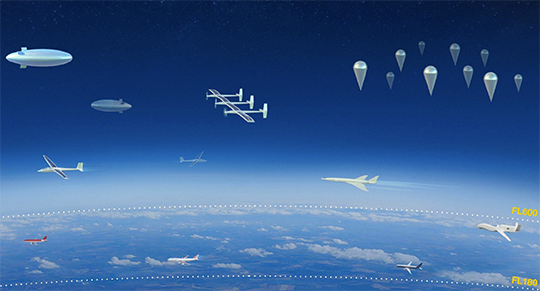|
|
 |

|
 |
 |
Upper-Class E Traffic Management (ETM) is an airspace management concept for National Airspace System (NAS) flight operations at or above FL600. As recent advances in technologies increase the demand in the stratospheric airspace, the diversity of vehicle types and the mixture of operating paradigms present new opportunities for a cooperative and interactive traffic management perspective.
ETM is part of the NAS Exploratory Concepts and Technologies (NExCT) Sub-Project of the Air Traffic Management-Exploration (ATM-X) project under the Airspace Operations and Safety Program (AOSP) within the Aeronautics Research Mission Directorate (ARMD).
What is Cooperative and Interactive Traffic Management?
By utilizing a Unmanned Aerial Systems (UAS) Traffic Management (UTM) inspired industry community-based approach, ETM operators can be responsible for coordination, execution, and management of operations through cooperative information exchanges. Operational separation from one another comes from shared intent, shared awareness, and tools supporting de-confliction and conformance monitoring. Creating these coalesced capabilities through services and network exchanges is anticipated.
Purpose and Research Approach
The purpose of this research is to establish an approach to cooperative-based traffic management and define the environment, architecture and data exchanges needed to enable an ETM system that is safe, scalable, and equitable. The system architecture explored shall enable operational planning, sharing of intent, deconfliction and conformance monitoring as well as airspace authorization, airspace management functions and identification of off-nominal situations. Verification and validation of these service functions will be performed through testing in which the differing vehicle types and performance characteristics of the ETM operators will interact with each other in the stratosphere as well as with traditional air traffic in climb, descent, and cruise (cooperative) phase operations. Development of the architecture will help with the framework for operating rules, procedures and overall roles and responsibilities of all stakeholders. Laboratory testing will involve early simulation of use cases and technology integration with the potential to lead to field tests with industry partners to ensure the stability and feasibility of the ETM assessment.
Role of the AOL in ETM
During simulations and flight tests, the Airspace Operations Laboratory (AOL) will serve as the base of operations for ETM systems integration, which incorporates systems and software from the AOL UTM-like architecture infrastructure to support ETM concepts. Some of the outcomes of this work include automation technology for operator negotiations, air traffic service coordination tools, display development, and human factors evaluation.

Illustration showing the diverse range of high-altitude vehicles that will be studied in the ETM Project
Point of Contact: Connie Brasil, M.S., Human Systems Integration Division, NASA Ames Research Center |
|
|